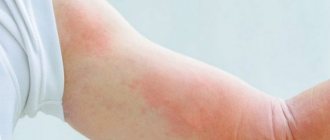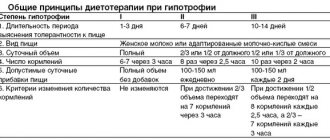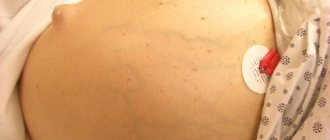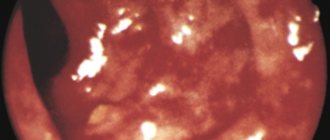Otolaryngologist for adults and children
Son of the gods
Stanislav Vladimirovich
24 years of experience
Otorhinolaryngologist of the highest category, Candidate of Medical Sciences, member of the European Rhinological Society (European Rhinologic Society)
Make an appointment
Tracheitis is an inflammatory process in the trachea caused by bacterial, viral or fungal infections. A distinctive feature of the pathology is systematic coughing attacks. Cough spasms lead to the release of copious sputum of a mucous or mucopurulent nature. Patients complain of severe chest pain before and after an attack.
Treatment of inflammation of the trachea is carried out under the supervision of a therapist, but the patient may need consultations with a phthisiatrician, allergist and pulmonologist. The basis of drug therapy is antibacterial, antiviral and antihistamine drugs. Additional uses include mucolytics, expectorants and antitussives.
Reasons for the development of tracheitis
Acute tracheitis of infectious origin occurs due to viruses and bacteria entering the body. Most of the pathogenic microflora turns out to be unviable in an aggressive environment. Therefore, the main method of infection is contact between a healthy person and a carrier of a viral or bacterial infection.
In some cases, tracheitis develops as a complication of influenza, measles, scarlet fever or chickenpox. Bacterial tracheitis is the result of pneumococci, staphylococci or streptococci entering the body. Research over the past 10 years has convincingly proven that the main cause of the development of the inflammatory process in the trachea is opportunistic microflora, which is constantly present in the respiratory tract.
The development of allergic tracheitis is facilitated by the presence of small particles in the inhaled air, tobacco smoke and unfavorable environmental conditions in the patient’s region of residence. Extremely dry or waterlogged air also has a significant impact. City residents often breathe through their mouths, which eliminates pre-cleaning of the air in the nasal cavity. Nasal breathing may be difficult due to rhinitis, sinusitis, deviated nasal septum or adenoids. Systematic hypothermia or irritation of the larynx can lead to the development of chronic tracheitis.
Treatment of tracheitis with medications
The doctor chooses medications for the treatment of inflammation of the trachea, taking into account the form of the disease. For this disease, antiviral, antihistamine, and expectorant medications are prescribed in the form of tablets, sprays, aerosols and syrups.
In some cases, antibiotics cannot be avoided. Such drugs are recommended in the development of an inflammatory process to suppress the growth of pathogenic microorganisms.
Warning signs that indicate that antibacterial therapy is required include: a severe cough for two weeks, a high temperature for several days, the spread of the inflammatory process to the tonsils, nasal and ear sinuses.
List of the most popular medications for the treatment of tracheitis:
- Lazolvan is a mucolytic with an expectorant effect. Available in the form of tablets and syrup for children.
- Erespal – enhances local respiratory protection
- Sinekod – suppresses cough. It is not recommended to be taken simultaneously with mucolytics.
- Berodual - quickly and effectively relieves tracheospasm and alleviates the condition during paroxysmal coughing.
- Sumamed is an antibiotic that has successfully proven itself for the treatment of upper and lower respiratory tract infections.
Tracheitis and traditional medicine
Folk remedies are a good way to alleviate the condition of a patient suffering from tracheitis. However, in acute cases of the disease, they are allowed only as an adjuvant. You should not give up traditional medicine to avoid complications.
To combat tracheitis at home, drinking plenty of warm fluids is recommended. Herbal decoctions, jelly, and warm milk dilute mucus and promote its removal.
Patients suffering from allergic reactions carefully select traditional methods of treating tracheitis. Some plants and honey can cause allergies and worsen the condition.
Warming procedures for the legs are useful for tracheitis. You can make baths with mustard powder or pour it into socks in dry form. At fever such manipulations are contraindicated.
Compresses made from boiled potatoes and rubbing the chest with animal fat have also worked well. But such procedures do not cure tracheitis, but relieve coughing attacks.
Inhalations for tracheitis
Inhalations are recommended to treat inflammation of the trachea. It is better to carry them out using a special device - a nebulizer. It helps to spray the medicine directly onto the inflamed mucous areas.
Very often the basis of inhalation is saline solution. It is absolutely safe for adults and children. Sodium hydrochloride moisturizes the mucous membrane of the larynx and nasopharynx, thereby alleviating the patient's condition. You can replace the saline solution with water with added soda or alkaline mineral water.
Medications such as lazolvan and other mucolytics are also used for inhalation. For tracheobronchitis, a procedure with berodual relieves spasms. A contraindication for the use of inhalations is elevated body temperature.
Additional recommendations for the treatment of tracheal inflammation
To get rid of the unpleasant symptoms of tracheal inflammation as quickly as possible, you should follow several recommendations:
- Eliminate spicy, salty and fatty foods from your diet. It is better to give preference to dietary porridges and broths. Don't forget to drink fluids. It should be warm, but not hot.
- Gargle and irrigate your throat with antiseptic solutions 3 times a day.
- If the disease is acute, stay in bed. Be sure to ventilate the room. Fresh air is one of the necessary conditions for fighting cough.
- If bacterial tracheitis is proven, do not neglect antibiotics. Taking them will help avoid the spread of infection and complications.
Types of tracheitis
Otolaryngologists distinguish 3 types of the pathology under consideration: infectious, allergic and infectious-allergic. Infectious tracheitis is represented by three variations: viral, bacterial and mixed.
Treatment of tracheitis and symptoms of concomitant diseases is impossible without taking into account the clinical picture. The course of the inflammatory process is considered by doctors as acute or chronic. The first type occurs suddenly; inflammation in the trachea is eliminated within 2 weeks. The chronic form of the disease is characterized by regular exacerbations, which are followed by periods of remission. Advanced tracheitis leads to changes in the morphology of the tracheal mucosa.
Diagnostics
For home treatment to be effective, consultation with a doctor is required. To accurately identify the disease, diagnosis may include the following studies:
- taking anamnesis;
- visual examination of the throat and sinuses;
- listening to breathing to detect wheezing;
- blood test to identify the inflammatory process;
- X-ray in two projections to differentiate tracheitis from bronchitis and pneumonia.
Ultrasound of the bronchi is less commonly used.
Note! If the treatment is ineffective and tracheospasms continue, a smear may be taken from the larynx to identify the causative bacteria.
When the function of the trachea is impaired, tracheoscopy can be used to examine the condition of the mucous membrane of the organ. This procedure is carried out by inserting a probe with a microchamber. By examining the windpipe, you can distinguish the type of pathology and select the best treatment.
Symptoms
The main signs of tracheitis are cough and sputum released during coughing. The first days the patient suffers from a dry cough. Mucous sputum appears 3-4 days after infection of a child or adult. Coughing attacks are accompanied by severe pain. Coughing movements occur involuntarily during deep breaths, loud conversation, hysterical crying or prolonged laughter. Pain sensations persist in the space behind the sternum for a long time. As the inflammatory process develops in the trachea, the amount of sputum produced increases and its consistency changes. With bacterial damage to the respiratory system, the discharge becomes purulent. For this reason, doctors insist on individual selection of medicine for tracheitis for each patient.
In the first days of the development of the inflammatory process, the patient feels an increase in body temperature. During the day, the indicators return to standard values, and in the evening they rise again. Symptoms of tracheitis may vary among representatives of different age groups. Thus, children and adolescents almost never encounter intoxication, which significantly worsens the condition of older people. Coughing attacks provoke sleep disorders in patients of all ages.
A characteristic feature of the pathological process in the trachea is an enlargement of the cervical lymph nodes. When palpating them, patients feel slight pain.
Symptoms of the disease
Tracheitis, the symptoms of which are known to many people, begins to develop in the body precisely at the moment of their appearance. Important: the first symptoms of the pathology are noticeable with the development of the acute form. Signs of tracheitis, which, according to doctors, are considered the main ones:
- dry morning cough;
- pain behind the sternum and in the throat;
- severe cough when changing body position, changing temperature, crying, laughing and screaming;
- pain when eating.
In this case, all patients try to breathe as little as possible so as not to provoke irritation of the trachea and its mucous membrane. During an attack, the above symptoms become more pronounced and painful. In children, the main symptom of the disease is shallow breathing, accompanied by frequency and rapid rhythm.
Important: a cough with tracheitis is significantly different from a sore throat. Even a minimal amount of sputum and mucus in the tracheal cavity causes severe hoarseness, which cannot be confused with other respiratory diseases. Symptoms include high body temperature, particularly in the morning. In adults it reaches 39 degrees. When the patient coughs, gray sputum is produced. Due to the fact that it is viscous, sputum comes out in minimal quantities. Immediately after this, the cough stops for a while.
If a person has a weakened immune system, along with the development of tracheitis, tracheobronchitis will begin to develop in the body, leading to a severe painful cough and a sharp rise in temperature. Treatment methods for tracheitis in adults are aimed at restoring the tracheal mucosa. In advanced cases, inflammation spreads to the lower respiratory organs (lungs, diaphragm). This is especially dangerous for children and the elderly.
The main symptom of the chronic form of tracheitis is a paroxysmal cough that does not stop at night. Important: coughing is accompanied by severe excruciating pain. Unpleasant sensations in the chest will “pursue” the patient until he begins to take medications that reduce the load on the mucous membrane.
Therapy
Based on the test results, the attending physician prescribes treatment for the patient. For bacterial tracheitis, antibiotics are used, for viral tracheitis, antiviral drugs are used. The allergic nature of the inflammatory process in the trachea becomes the reason for prescribing antihistamines to a child or adult. Expectorants and mucolytics help remove mucus from the patient's respiratory system. In the chronic type of tracheitis, persons suffering from seasonal exacerbations receive immunomodulatory drugs.
Folk remedies
It is impossible to cure chronic tracheitis with folk remedies alone. And all the recipes presented below can only act as concomitant therapy for the disease:
- Mustard plasters. This remedy is not so much therapeutic as it is distracting in nature. Due to irritation of skin receptors, the frequency and strength of coughing attacks is reduced. You can use ready-made mustard plasters or prepare them yourself by wrapping a mixture of flour, mustard powder, honey, vegetable oil and vodka in a cloth. The maximum duration of the procedure for adults is 15-20 minutes; for children this time should not exceed 10 minutes.
- Herbal inhalations. Mix eucalyptus, sage, chamomile, mint and thyme in equal proportions. Pour boiling water over it all and boil for half an hour. Strain the finished broth and use for steam inhalation. The drug is prohibited for the treatment of tracheitis with an allergic component.
- Steam inhalation over boiled potatoes.
- Foot baths with mustard powder.
- Warming compresses on the throat. Honey is used as the basis for the compress, to which any of the ingredients convenient for you is added - horseradish, camphor alcohol, boiled potatoes or essential oil. The method is contraindicated for completely dry cough. It is safe to use a few days after the start of treatment, when the cough becomes wet.
Any warming procedures are prohibited at elevated body temperatures, for example, during exacerbations. And this is not the only nuance of home treatment. Therefore, before using any folk remedy, consult your doctor.
Questions and answers
How to avoid the transition of acute tracheitis to the chronic stage?
It is possible to prevent the transition of acute pathology to chronic only with timely initiation of treatment. The patient should follow all instructions of the therapist or otolaryngologist and not reduce the recommended daily dosage of medications. A consultation with an immunologist will be useful - the doctor will tell you about the basic principles of strengthening immunity and select immunomodulators that are suitable for a child or adult.
Last stage of treatment
The transition to the last stage of treatment involves the use of powerful drugs, be it mucolytics or other antibiotics. These funds, of which there may be no more than three, must be used in strict accordance with the recommendations of a pulmonologist or phthisiatrician. When the first negative reactions from the body appear, you need to quickly consult a doctor.
It is equally important at this stage, when essentially the entire body is being treated, to introduce vitamin and mineral complexes. This will strengthen the immune defense, speed up metabolism and similar processes, and also increase the body's resistance. If symptoms of chronic or acute inflammation are present, it is permissible to use more medications in order to cure the body as quickly as possible.
When the recovery cycle has come to an end, everyone who is faced with the presented disease should:
- undergo a thorough diagnostic examination and do this not just once, but every six months in the future;
- avoid any contact with those who are at risk, have an aggravated immune condition and other abnormalities;
- lead a healthy and physically active lifestyle.
In order to consolidate the resulting restorative effect and be sure that the drugs have 100% helped treat tracheitis, it is necessary to consider using additional methods of influence. This will help all adults: women and even older people.









